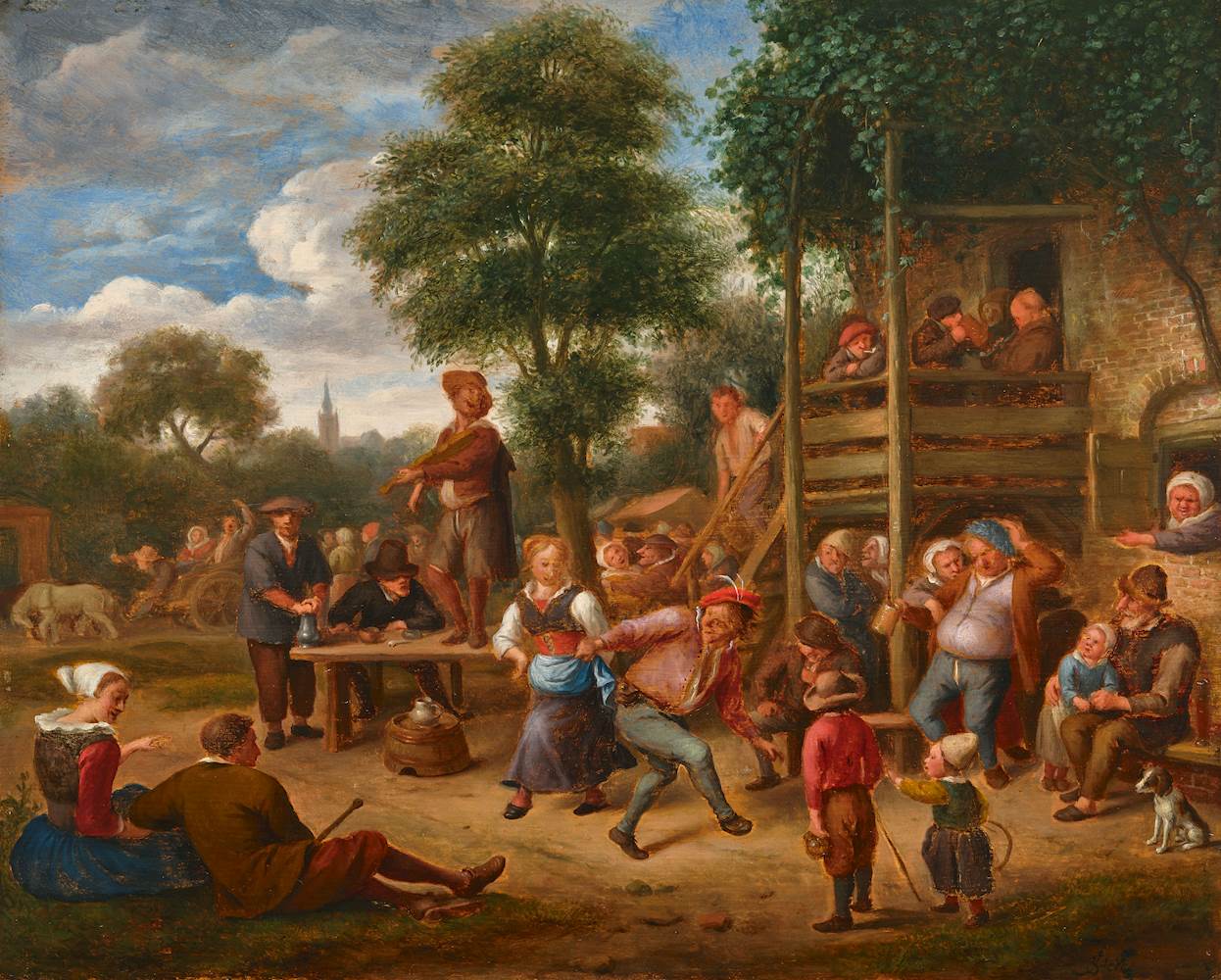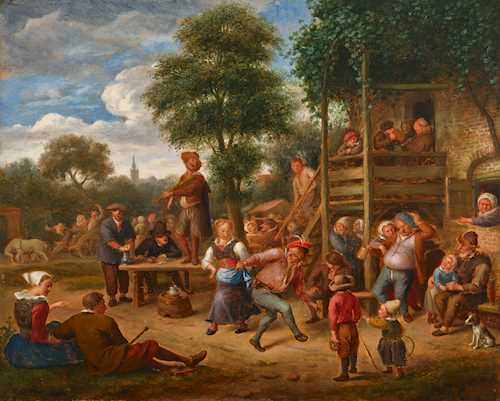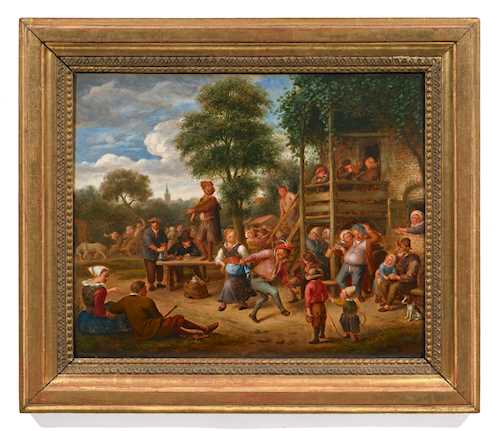
Lotto 3032* - A210 Dipinti antichi - venerdì, 20. settembre 2024, 14h00
JAN STEEN
(1626 Leiden 1678)
Cheerful company before an inn.
Oil on panel.
Signed below right: JS (ligated) teen.
40.4 × 50 cm.
Provenance:
- Von Nell collection.
- By descent, European private collection.
Exhibited:
Museum Wiesbaden - Hessisches Landesmuseum für Kunst und Natur, 2008–2024, permanent loan.
This painting is an early work by Jan Steen, where the artist, well-known for his merry companies, already shows the characteristics of his art. Dr Fred G. Meijer dates this scene in the early 1650s, and confirms that this painting was part of a production created for the market rather than a commission, attesting to the popularity of such subjects at that time.
The scene takes place in front of a crowded inn with a landscape in the background. In the middle of the composition a merry couple is dancing to the rhythm of the music played by a violinist. The large variety of characters, representing children with their toys watching the scene, a drunk man with his fly open supported by his wife, and a smiling grandfather hugging a young child, is representative of Steen‘s fine observation of the human condition. Painted in soft colour tones, this work is an extraordinary example of Steen’s early technique and style. Whereas the later works are painted in great detail, the early paintings such as this one represent characteristic faces in a vivid manner. The painting "Peasants dancing at an inn", (c. 1646–48, oil on panel, 40,2 × 57,5 cm, Mauritshuis, The Hague, inv.-no. 553) comparably shows how Steen is able to suggest the dancers’ movements and the laughing faces, therefore depicting joyful moods in a simple but efficient way.
Jan Steen was born in Leiden c. 1626 in a family of Catholic brewers, allowing the painter to experience first-hand the merriness of taverns and inns that his parents frequented for their business. He received his education as a painter before co-founding in 1648 the painters’ Guild of Saint Luke in Leiden, which became an important association for professional artists. Arnold Houbraken (1660–1719), the biographer of the most famous seventeenth-century Dutch artists, described Steen as ‘farcical’ and ‘ever jolly of spirit’, stating that ‘he was able to express things by his intellect and brush, both with respect to the depiction of nature and the manner of painting, that are worthy of admiration’ (Arnold Houbraken: The great theatre of the Netherlandish painters and paintresses, 1718. Online translation 2021, vol. 1, p. 374). It is this characteristic that made the artist’s fame, and that one can readily observe in this artwork. Steen is known to include self-portraits in group scenes, which demonstrates his self-awareness and self-depreciation. The violinist of this painting bears similarities with his traits, which could suggest his ambition to include himself in his compositions at an early stage of his career.
This work is also attractive for its particular provenance, as it has been in the possession of the family Von Nell for centuries. The earliest ancestor can be traced back to 1643, namely Christian Nell in Wallersheim near Koblenz. He built his fortune as a raftsman and timber merchant, a business that his descendants perpetuated for generations. Merchants like him transported raw materials on a raft, a kind of a floating island navigating on the Rhine, and furnished cities along the river with oak and beech timbers for various economically significant constructions. The close connection between the Netherlands and this profession suggests that Christian Nell, his son Peter Christian, or one of their descendants could have purchased the painting by Steen on the Dutch market.
During the Thirty Years War, raftsmen, who became wealthy from their trade, financially supported the princes and towns. To thank Peter Christian Nell for his services, the emperor Charles VI awarded him the knightly imperial and hereditary Austrian nobility as von Nell zu Thomenacher in 1709, therefore raising the social status of the family’s Rhenish line. The emperor recognised the coat of arms of the Von Nell as decorated with an ear of corn and a fish labelled as a dolphin or a whale, as illustrated in Fig. 1.
Since 2008 until now this painting was on long-term loan to the Museum Wiesbaden, where it was exhibited to the public.
The painting is archived in RKD, The Hague, as an authentic artwork by Jan Steen under the number 313806.
The scene takes place in front of a crowded inn with a landscape in the background. In the middle of the composition a merry couple is dancing to the rhythm of the music played by a violinist. The large variety of characters, representing children with their toys watching the scene, a drunk man with his fly open supported by his wife, and a smiling grandfather hugging a young child, is representative of Steen‘s fine observation of the human condition. Painted in soft colour tones, this work is an extraordinary example of Steen’s early technique and style. Whereas the later works are painted in great detail, the early paintings such as this one represent characteristic faces in a vivid manner. The painting "Peasants dancing at an inn", (c. 1646–48, oil on panel, 40,2 × 57,5 cm, Mauritshuis, The Hague, inv.-no. 553) comparably shows how Steen is able to suggest the dancers’ movements and the laughing faces, therefore depicting joyful moods in a simple but efficient way.
Jan Steen was born in Leiden c. 1626 in a family of Catholic brewers, allowing the painter to experience first-hand the merriness of taverns and inns that his parents frequented for their business. He received his education as a painter before co-founding in 1648 the painters’ Guild of Saint Luke in Leiden, which became an important association for professional artists. Arnold Houbraken (1660–1719), the biographer of the most famous seventeenth-century Dutch artists, described Steen as ‘farcical’ and ‘ever jolly of spirit’, stating that ‘he was able to express things by his intellect and brush, both with respect to the depiction of nature and the manner of painting, that are worthy of admiration’ (Arnold Houbraken: The great theatre of the Netherlandish painters and paintresses, 1718. Online translation 2021, vol. 1, p. 374). It is this characteristic that made the artist’s fame, and that one can readily observe in this artwork. Steen is known to include self-portraits in group scenes, which demonstrates his self-awareness and self-depreciation. The violinist of this painting bears similarities with his traits, which could suggest his ambition to include himself in his compositions at an early stage of his career.
This work is also attractive for its particular provenance, as it has been in the possession of the family Von Nell for centuries. The earliest ancestor can be traced back to 1643, namely Christian Nell in Wallersheim near Koblenz. He built his fortune as a raftsman and timber merchant, a business that his descendants perpetuated for generations. Merchants like him transported raw materials on a raft, a kind of a floating island navigating on the Rhine, and furnished cities along the river with oak and beech timbers for various economically significant constructions. The close connection between the Netherlands and this profession suggests that Christian Nell, his son Peter Christian, or one of their descendants could have purchased the painting by Steen on the Dutch market.
During the Thirty Years War, raftsmen, who became wealthy from their trade, financially supported the princes and towns. To thank Peter Christian Nell for his services, the emperor Charles VI awarded him the knightly imperial and hereditary Austrian nobility as von Nell zu Thomenacher in 1709, therefore raising the social status of the family’s Rhenish line. The emperor recognised the coat of arms of the Von Nell as decorated with an ear of corn and a fish labelled as a dolphin or a whale, as illustrated in Fig. 1.
Since 2008 until now this painting was on long-term loan to the Museum Wiesbaden, where it was exhibited to the public.
The painting is archived in RKD, The Hague, as an authentic artwork by Jan Steen under the number 313806.
CHF 60 000 / 100 000 | (€ 61 860 / 103 090)


